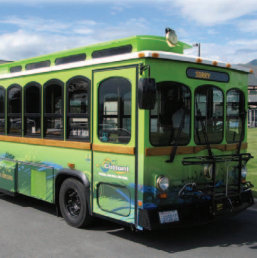
Link Transit is incorporating vehicle efficiency technology into its Wenatchee bus fleet by purchasing five electric trolley buses along with charging stations. The 22-foot, low floor, accessible electric trolley buses will operate on two downtown routes in Wenatchee, Washington.
This $2.9 million TIGGER project will reduce greenhouse gas (GHG) emissions by utilizing renewable electricity to power five all-electric buses. Link Transit is located near the Columbia River in central Washington, where four hydroelectric dams and numerous wind turbines provide Link Transit with 100% renewable electrical power for charging these buses.
Additionally, these five electric buses will displace five conventional diesel-powered buses in Link Transit’s fleet, thus contributing to a reduction in GHG emissions. This project incorporates four technologies that are new the public transit industry:
- NanoSafe lithium ion (titanate matrix) batteries manufactured by Nevada-based Altairnano.
- Innovative battery balancing software to keep all of the 256 individual cells at a uniform voltage, which optimizes the performance and range of the trolley
- A battery cooling system that will further increase the life of the batteries through active temperature management.
- Automated, rapid, hands-free, stationary opportunity charging equipment manufactured by California-based Ebus, Inc
The NanoSafe batteries are predicted to have 6,000 full recharge cycles, giving each battery an effective life span of 6 years in the Link Transit duty cycle. This means that Link Transit will have to replace the battery package at the mid-life point of the bus. While the cost of replacing the battery pack will be significant, the relatively low local power costs will offset the cost. At current diesel prices, it would cost Link Transit an estimated $99,690 to fuel a diesel-powered vehicle in this service over a 12-year period. The battery-electric buses use 12 kilowatts per hour, which—at Link Transit’s current power rates—adds up to $11,664 over the 12-year life of the vehicle. The estimated $88,000 in savings will cover the cost of battery replacement.
The new charging equipment is designed to safely allow passengers to get on and off the bus at the same time the vehicle is being charged. The automated, rapid, hands-free, stationary opportunity charging equipment enables the bus driver to quickly position the vehicle into its dedicated boarding area and provides an automated connection so the driver doesn’t have to plug cables into a receptacle. The system incorporates a charging plug that is attached to a stationary vertical tower; this electrical plug is pneumatically deployed and contacts the charging receptacle located on the trolley roof.
The charging station delivers 320 kW of electrical power to the bus in approximately four minutes, which allows the battery-powered bus to maintain the same service cycle as the conventional diesel-powered buses. Two quick-charge stations are located at Link Transit’s Intermodal Transportation Center (Columbia Station) in downtown Wenatchee, and the trolley buses charge for approximately 5 minutes while they lay over at the station every 30 minutes. The electric buses have a range of approximately 20 miles after charging.
This project demonstrates the practicality and feasibility of using all-electric, lithium ion titanate battery-powered transit vehicles on traditionally dieselpowered transit routes in order to greatly reduce, if not fully eliminate, the greenhouse gas emissions associated with these routes. In addition, the electric-powered vehicles have improved efficiency and reduced Link Transit’s overall energy use. This project will serve as a precedent for other transit agencies to replicate.